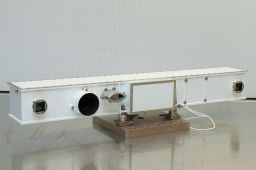What’s the first stop for a rover destined to search for signs of life on the Red Planet? Toulouse in France, apparently.
Of course, this isn’t actually part of the European Space Agency’s (ESA) ExoMars rover’s nine-month journey to Mars, but it is where the vehicle will receive crucial testing, before heading off into space.
Europe’s first planetary rover, dubbed “Rosalind Franklin,” has now been built and taken its next step towards space travel. UK Airbus engineers displayed the finished vehicle, scheduled to launch in July 2020, before dispatching it on its journey.
The rover has a clear mission: to find out if there is life on Mars.
“Seeing the Rosalind Franklin rover finally leave Airbus in Stevenage is a great moment, and I would like to thank all the teams involved for their efforts in making this happen,” Colin Paynter, managing director of Airbus Defence and Space UK, said.
The rover itself is a complicated combination of instruments, all fine-tuned to help scientists make a step-by-step exploration of the Martian surface.
It is equipped with a 2-meter (6.6-foot) drill to help dig below the surface of Mars and discover parts of the planet unharmed by radiation. Mars’ surface is believed to be very radioactive, meaning life is unlikely to be found on the surface.
And last week, the rover’s eyes were fitted. Or more precisely, the cameras which will help the vehicle see and search for signs of life.

The core design of the panoramic camera system called PanCam came from a team at University College London (UCL), who told CNN that their hard work was actually “surprisingly simple.”
But they nevertheless had to overcome a lot of challenges to design three cameras able to withstand a trip to Mars.
If the radiation and distance wasn’t enough of a worry, temperatures on Mars can drop as low as -130 degrees Celsius (184°F) during the night and rise to up to 20°C (68°F) during the day, according to Mary Carter, Pan-Cam project manager.
In Toulouse, the rover will be tested to ensure it can survive its launch from Earth next summer and the extreme weather conditions of Mars when it lands on the planet in March 2021.
The UK Space Agency, the second largest European contributor to the ExoMars mission, having invested €287 million ($318 million), commended the rover’s completion.
“As we hand the rover over to France for final testing, we should celebrate the huge efforts of the hundreds of people across the UK who have been involved in the design and build of the rover and its instruments,” Dr Graham Turnock, CEO of the UK Space Agency, said.
While the rover is only moving between European countries now, there is real anticipation that discoveries can be made when it eventually makes the voyage to another planet.
“We’re looking forward to completing the final rounds of tests before the rover is declared flight ready and closed inside the landing platform and descent module that will deliver it safely to the surface of Mars,” Dr David Parker, director of human and robotic exploration at the European Space Agency, said.

